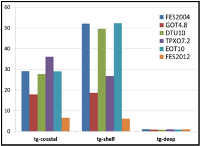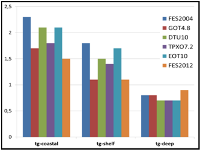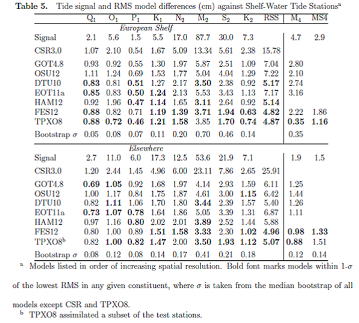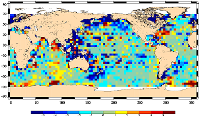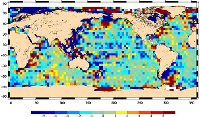Global tide - FES2012
FES2012 is a version of the FES (Finite Element Solution) tide model developped in 2012. It is a fully revised version of the global hydrodynamic tide solutions initiated by the works of Christian Le Provost in the early nineties. The new model has been developed, implemented and validated by the LEGOS, NOVELTIS and CLS, within a CNES funded project.
FES2012 takes advantage of longer altimeter time series, improved modelling and data assimilation techniques, and more accurate ocean bathymetry. Special efforts have been dedicated to address the major non-linear tides issue and to the determination of accurate tidal currents.
FES2012 is based on the resolution of the tidal barotropic equations (T-UGO model) in a spectral configuration.
A new original high resolution global bathymetry was built, and a new global finite element grid (~1.5 million nodes) is used leading to a twice more accurate 'free' solution (independent of in situ and remote-sensing data) than the FES2004 version. Then the accuracy of this 'free' solution was improved by assimilating long-term altimetry data (Topex/ Poseidon, Jason-1, Jason-2, ERS-1, ERS-2 and ENVISAT) through an improved representer assimilation method. Final FES2012 solution shows strong improvement compared to FES2004 and GOT4V8, particularly in coastal and shelf regions and although none tidal gauge has been assimilated yet.
32 tidal constituents are distributed on 1/16° grids (amplitude and phase).
New tide loading effects have not yet been computed for FES2012, thus users should use GOT4V8 tide loading to be fully compliant with the construction of the FES2012 atlas.
A new prediction algorithm is distributed within the FES2012 package to provide tidal heights and currents at any location of the world ocean. This new prediction code allows computing 11 complementary HF constituents by the means of a specific admittance method and about 100 long period equilibrium ocean waves
Validation versus tide gauge and altimetry:
Main improvements between FES2012 and FES2004
- refinement of the finite element mesh (~1.000.000 points to ~1.500.000 elevation points)
- revised assimilation scheme
- new global bathymetry including most recent global and regional datasets
- improved coastlines in Antarctic
- take into account ice coverage in polar areas
- assimilation of long time series of altimetric data (Topex/Poseidon, Jason-1, Jason-2, ERS-1, ERS-2 end Envisat): crossovers and along-track data
- only 3 tide gauges have been assimilated to improve locally the solution
- several non linear hydrodynamic waves are included: M4, M6, M8, MN4, MS4, MKS2, N4, S4, MSf (great benefits for coastal areas)
- S2 tide benefits from a specific atmospheric forcing computed from ECMWF 3h-DCDA-analysis
- five long period hydrodynamic waves are used: Mf, Mm, Mtm, Msqm, Ssa (and removed from the Cartwright long period tide algorithm...)
- the prediction code was fully revised and optimized to take into account new waves and loading effects (C routines)
- the gridded resolution of the distributed package is now 1/16° instead of 1/8°




















